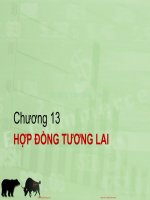bài tập Đầu tư tài chính
Bạn đang xem bản rút gọn của tài liệu. Xem và tải ngay bản đầy đủ của tài liệu tại đây (32.14 KB, 2 trang )
Question 1:
Assume that return of portfolio A is described by the following regressed model:
r = 10% + 0.6*GDP - 0.2*INT - 0.4*INF + e.
Risk premiums of macro-economic factors in the above model has the following values:
-
Risk premium of GDP: 8%
Risk premium of INT: 6%
Risk premium of INF: 4%
Risk free rate is 6%. What is expected return of portfolio A based on APT theory. Is there any
Arbitrage opportunity? Please describe Arbitrage strategy of the investor to exploit the Arbitrage
opportunity if it exists.
Question 2:
Mr. Kay has a plan of buying an apartment. He has to borrow from a bank with 12%/year interest
rate, the borrowing time is 4 year and the amount of money (including principal and interest) to
be paid each year is 400 million VND.
To immunize the interest rate risk of his loan, Mr. John invests in bond A and bond B:
- Bond A ‘s maturity time is 3 years, coupon rate is 12%.
- Bond B ‘s maturity time is 4 years, coupon rate is 10%.
Both bond A and bond B pay coupon annually, the face value of bond A and bond B is 600 millions
VND. Yield to maturity or the market rate is 10%
a. Calculate Macaulay duration and Modified duration of bond A and bond B. When yield to
maturity decreases 1%, how price of bond A and bond B change?
b. What is the invested weight of bond A and bond B that Mr. John needs to invest to immunize
interest rate risk of his loan?
Question 3:
Show the Payoff Table and draw Payoff Diagram of the following portfolio:
-
Buy 1 call option with strike price (X1) $120.
Sell 1 call option with strike price (X2) $150
Buy 1 put option with strike price (X3) $120
Know that all above options are European Option, have the same maturity and right on the same
stock.
Question 4:
Expected return and risk of stock A and stock B as follow:
Stock
Expected return
Beta
Unique standard deviation
(Ϭei)
A
15%
0,8
32%
B
20%
1,2
45%
Standard deviation of market index is 24% and risk free rate is 9%.
a. Calculate the standard deviation of stock A and stock B
b. A Portfolio is created with the folloing invested weight:
Stock A: 35%
Stock B: 45%
Risk free asset: 20%
Please calculate expected return, beta coefficient, total standard deviation and unique
deviation of the portfolio.
Question 5:
If CAPM theory is efficient, which of the following situation can or cannot be exist? Give
explanation.
Situation
1
2
3
Situation
4
Portfolio
A
B
Risk free
Market
A
Risk free
Market
A
Expected return
30%
40%
8%
16%
15%
8%
16%
18%
Standard deviation
35%
30%
0
22%
14%
0
22%
30%
Portfolio
Risk free
Market
A
Expected return
8%
16%
18%
Beta Coefficient
0
1
1,5









